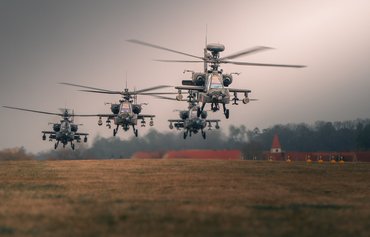Bahrain's acquisition of AH-1Z Viper helicopters will vastly advance the small Gulf country's ability to deter threats and respond to future crises in the region.
Bahrain has so far received six out of 12 helicopters as part of a deal inked with the United States in February 2019.
Production on the remaining six was completed in December 2022, and they are expected to be delivered this year, said Bell, the company that manufactures the helicopter, in February.
Bahrain is the first export customer of the AH-1Z Viper under the 2019 deal, which was worth $912 million and included air-to-ground missiles and precision-guided rockets.
![An AH-1Z Venom helicopter takes off from the amphibious assault ship USS Makin Island on March 29. [US Navy]](/cnmi_am/images/2023/05/10/41954-230329-m-fw664-1616-600_384.jpg)
An AH-1Z Venom helicopter takes off from the amphibious assault ship USS Makin Island on March 29. [US Navy]
"This proposed sale will contribute to the foreign policy and national security of the United States by helping to improve the security of a major non-NATO ally which is an important security partner in the region," the US Defence Security Co-operation Agency said in the 2018 statement authorising the deal.
"Our mutual defence interests anchor our relationship and the Royal Bahraini Air Force plays a significant role in Bahrain's defence," it continued.
The AH-1Z is an armed escort, reconnaissance, close air support and anti-armour platform used by the US Marine Corps (USMC).
Derived from the AH-1 Cobra that entered US military service in 1962, the AH-1Z achieved initial operating capability with the USMC in 2011.
The Viper
The AH-1Z Viper is equipped with a variety of advanced armaments that make it a highly effective attack helicopter.
One of its primary weapons is a three-barrel M-197 20mm cannon, which is mounted on the underside of the helicopter's nose and is capable of firing up to an estimated 1,500 rounds per minute.
The AH-1Z Viper can also carry a variety of missiles, including up to 16 AGM-114 Hellfire air-to-ground missiles.
The Hellfire has a "fire-and-forget" capability, which means it can hit targets without further guidance after launch and without the launcher requiring line-of-sight of the target.
The latest iteration of the well-tested air-to-ground missile, the AGM-114R Hellfire II, can be used against soft, hard and enclosed targets and can be launched from higher altitudes than previous versions.
The Viper's other armaments include two AIM-9 Sidewinder air-to-air missiles mounted on each wing tip station and up to 76 Hydra 70 rockets.
The Hydra 70 can use nine different warheads to give the AH-1Z air-to-ground suppression, smoke screening, illumination, and direct and indirect fire capabilities at close and extended ranges.
The most common warhead for the rocket is the M151 "10-Pounder", which has a blast radius of 10 metres and lethal fragmentation radius of about 50 metres.
The unguided rocket can also be upgraded into a precision-guided munition with the APKWS II, which adds a mid-body guidance unit.
The AH-1Z Viper's weapons are integrated with the helicopter's advanced avionics suite, and a helmet-mounted sight.
These systems work together to enable the pilot to acquire and engage targets with precision, even in low light or adverse weather conditions.
The helmet-mounted sight, in particular, allows the pilot to target and engage threats simply by looking at them, enabling rapid and accurate engagement of multiple targets.
Link 16 connectivity
An added advantage of the AH-1Z Viper is its connection to the Link 16 system, which allows the helicopter to communicate with other assets -- such as artillery or fighter jets -- in engaging targets.
Link 16 at its core is a communication system for transmitting and exchanging real time tactical data among the US military, NATO and other allies.
It provides a secure, jam-resistant, high-speed digital data link that operates at radio and microwave frequencies.
The network enables a range of platforms, including aircraft, surface ships, ground vehicles, missile defence systems, networked weapons and command-and-control networks, to exchange text, imagery and digital voice messages.
In addition, Link 16 provides relative navigation capability and precise participant location and identification, according to BAE Systems.
Link 16 enables "the AH-1Z to rapidly share information with other weapon systems, provide greater situational awareness, accelerate the kill chain, and enhance survivability to outmanoeuvre and defeat the threat across a range of military operations", US Naval Air Systems Command said in June 2021 as it was testing the system.
For Bahrain, Link 16 means that the AH-1Z attack helicopter will be able to instantaneously establish dynamic targeting capability with allies that use the system, including the United States.

![AH-1Z Vipers during a live-fire training in Japan. [US Marines]](/cnmi_am/images/2023/05/10/41811-3030430-600_384.jpg)







So Bahrain goes to war against whom?! Or is it a royalty for America?
Reply1 Comment(s)